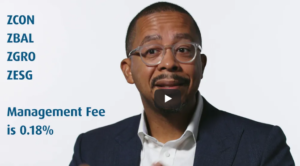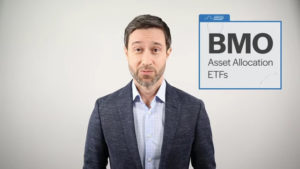This article has been sponsored by BMO Canada. All opinions are my own.
 I’m on record to say that the vast majority of self-directed investors should simply use a single asset allocation ETF to build their investment portfolios.
I’m on record to say that the vast majority of self-directed investors should simply use a single asset allocation ETF to build their investment portfolios.
What’s not to like about asset allocation ETFs? Investors get a low cost, risk appropriate, globally diversified portfolio in one easy to use product. It’s a fresh take on an old idea – the global balanced mutual fund – updated for the 2020’s using low-cost ETFs.
Investors don’t even have to worry about rebalancing their portfolio when they add or withdraw money, or when markets move up and down. Asset allocation ETFs automatically rebalance themselves regularly to maintain their original target asset mix.
This article looks at BMO’s line-up of asset allocation ETFs, which include a conservative (ZCON: 40/60), balanced (ZBAL: 60/40), growth (ZGRO: 80/20), and balanced ESG (ZESG: 60/40) option.
For a YouTube video about these ETFs, click here.
These BMO asset allocation ETFs are available for self-directed investors to purchase through their online brokerage account. Notably, these ETFs can be traded commission-free through BMO InvestorLine and Wealthsimple Trade.
What’s inside BMO’s Asset Allocation ETFs?
Launched in February 2019, BMO’s core asset allocation ETFs are made up of seven underlying ETFs representing various asset classes and geographic regions.
On the equity side we have:
- ZCN – BMO S&P/TSX Capped Composite Index ETF
- ZSP – BMO S&P 500 Index ETF
- ZEA – BMO MSCI EAFE Index ETF
- ZEM – BMO MSCI Emerging Markets Index ETF
While on the fixed income side we have:
- ZAG – BMO Aggregate Bond Index ETF
- ZGB – BMO Government Bond Index ETF
- ZMU – BMO Mid-Term US IG Corp Bond Hedged to CAD Index ETF
Altogether these seven ETFs represent nearly 5,000 individual stock and bond holdings from around the world.
In terms of geographic equity allocation, the BMO asset allocation ETFs hold 25% in Canadian stocks, 25% in international stocks, 40% to 41.25% in US stocks, and 8.75% to 10% in emerging market stocks.
BMO reviews their portfolios quarterly and will rebalance any fund that is more or less than 2.5% off from its target weight. In reality, these funds are rebalanced regularly with new cashflows from new investors.
BMO’s Balanced ESG ETF (ZESG) is made up of six underlying ETFs, including:
- ESGY – BMO MSCI USA ESG Leaders Index ETF
- ZGB – BMO Government Bond Index ETF
- ESGA – BMO MSCI Canada ESG Leaders Index ETF
- ESGE – BMO MSCI EAFE ESG Leaders Index ETF
- ESGB – BMO ESG Corporate Bond Index ETF
- ESGF – BMO ESG US Corporate Bond Hedged To CAD Index ETF
The management expense ratio for each of the BMO asset allocation ETFs is 0.20%. There is no duplication of fees or additional charges for the underlying ETFs.
Performance of BMO Asset Allocation ETFs
Now let’s look at the performance of each of BMO’s asset allocation ETFs.
BMO Growth ETF – ZGRO
The most popular asset allocation ETF in the line-up is BMO’s Growth ETF – ZGRO, with $119.5 million in assets under management. ZGRO is the 80% stock / 20% bond version.
Here are the calendar returns for ZGRO since inception:
- 2019: 11.07%
- 2020: 10.69%
- 2021 (July 31): 9.33%
ZGRO’s top holding is ZSP (US equities), which makes up 33.5% of the fund, followed by ZCN (Canadian equities), which makes up 20% of the fund.
BMO Balanced ETF – ZBAL
BMO’s Balanced ETF (ZBAL) represents the classic 60/40 balanced portfolio. ZBAL has $118.9 million in assets under management.
Here are the calendar returns for ZBAL since inception:
- 2019: 9.65%
- 2020: 10.27%
- 2021 (July 31): 6.34%
ZBAL’s top holding is ZAG (Canadian aggregate bonds) at 26% of the fund, followed by ZSP (US equities) at 25% of the fund.
BMO Conservative ETF – ZCON
BMO’s Conservative ETF portfolio (ZCON) has $47.5 million in assets under management and represents a 40% stock / 60% bond portfolio.
Here are the calendar returns for ZCON since inception:
- 2019: n/a
- 2020: 9.77%
- 2021 (July 31): 3.38%
ZCON’s largest holding is ZAG (Canadian aggregate bonds) at 40% of the fund, followed by ZSP (US equities) at 17% of the fund.
BMO Balanced ESG ETF – ZESG
Finally, we have BMO’s Balanced ESG ETF (ZESG), which was launched in January 2020. The fund has gathered assets of $46.75M so far. The Sustainable Economist Tim Nash said of ZESG, “I’m thrilled to have it as an option for sustainable investors.”
Here are the calendar returns for ZESG since inception:
- 2019: n/a
- 2020: 8.51%
- 2021 (July 31): 7.90%
ZESG’s largest holding is ESGY (US equities) at 32.5%, followed by ZGB (Canadian government bonds) at 23.5%.
Final Thoughts
BMO’s asset allocation ETFs may fly under the radar compared to its Vanguard and iShares competitors. But they absolutely deserve a look for self-directed investors who want to build a simple, low cost, globally diversified portfolio with a single-ticket solution.
BMO’s asset allocation ETFs have a lower MER than Vanguard’s products, and are on par with iShares’ asset allocation ETFs at 0.20% MER.
PWL Capital’s Justin Bender reviewed BMO’s asset allocation ETFs (ZCON, ZBAL, ZGRO) and compared them to iShares’ XCNS, XBAL, and XGRO.
Mr. Bender came to the same conclusion that BMO’s asset allocation ETFs, “deserve your attention as well.” To see his YouTube video on them, click here.
The bottom line: DIY investors can use BMO’s core asset allocation ETFs to build a globally diversified and risk appropriate portfolio with just a single ETF.
Furthermore, socially conscious investors looking for an easy way to build a diversified ESG portfolio can do so with BMO’s Balanced ESG ETF Portfolio (ZESG).
 In addition to running the Boomer & Echo website, Robb Engen is a fee-only financial planner. This article originally ran on his site on Sept. 22, 2021 and is republished here with his permission.
In addition to running the Boomer & Echo website, Robb Engen is a fee-only financial planner. This article originally ran on his site on Sept. 22, 2021 and is republished here with his permission.




Does that mean that as a (retired) DIY investor with just over a $2M I simply buy VBAL on all my accounts (non-reg, RRSP, RIFF, TFSA) and… forget about it?
How to manage the monthly income I need to live on?
Do I sell a portion of VBAL every month?
Thanks for sharing your ideas!
At BMO, the equivalent of Vanguard’s VBAL is ZBAL. In the case of Vanguard, VRIF is similar to VBAL/ZBAL but is slightly more conservative with a 50/50 asset mix. But the 4% return target might make it attractive in a RRIF.
BMO needs to add something like VEQT that is 100% equity. As per Robb Engen preference from other articles. I would not buy anything holding bond funds at all at this time unless very short duration bonds. 1-3 yr.